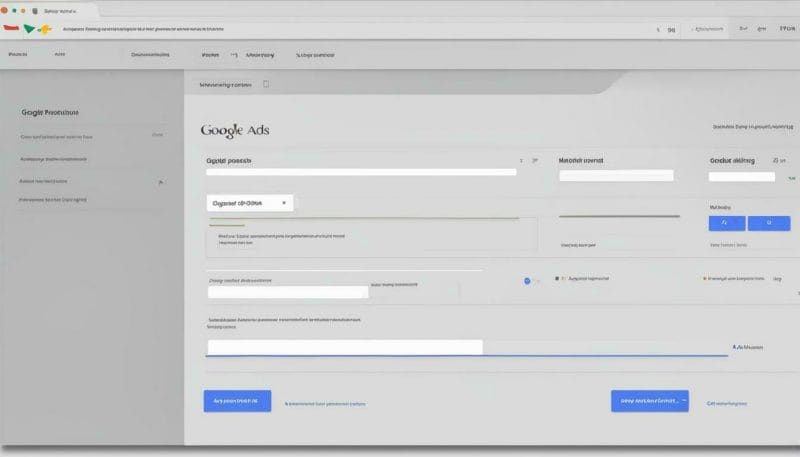Are you struggling with how to set up ads on Google? Look no further, as Loudachris Digital Marketing is here to make the process seamless for businesses across Australia. With our expertise and proven strategies, we can help you increase the ad strength of your campaigns and maximise your return on investment.
Key Takeaways
- Ad strength is an important tool provided by Google Ads to optimise ad performance.
- Implement at least one responsive search ad with good or excellent ad strength in each ad group.
- Improve ad strength by adding more headlines, descriptions, unique messaging, and relevant keywords.
- Monitor ad strength even after reaching a good or excellent rating.
- Ad strength does not directly impact ad rank or quality score, so pay attention to other factors like quality score and optimization score.
As experienced advertisers, we understand the importance of creativity and performance-driven strategies. By partnering with Loudachris Digital Marketing, you gain access to a results-based approach and personalised attention. We work with fewer clients to ensure quality and deliver the desired results. Trust us to guide you through the process of setting up ads on Google and watch your business thrive.
Stay tuned for our upcoming sections, where we will provide a step-by-step tutorial, discuss targeting options, bidding strategies, ad performance optimisation, best practices, and more.
Google Ads Setup Guide: Step-by-Step Tutorial
Setting up ads on Google may seem daunting, but with our comprehensive step-by-step guide, you’ll be on your way to advertising success in no time. Whether you’re a small business owner or a marketing professional, understanding the process and following the right steps is crucial to achieving your advertising goals.
Here’s a breakdown of the key steps involved in setting up ads on Google:
- Create a Google Ads account: The first step is to create an account on the Google Ads platform. Simply visit the Google Ads website and follow the registration process. Once your account is set up, you’ll have access to a range of powerful tools and features.
- Define your advertising goals: Clearly define your advertising objectives, whether it’s to increase website traffic, generate leads, or boost sales. This will help you tailor your ad campaigns and select the right targeting options to reach your desired audience.
- Research and select keywords: Conduct keyword research to identify relevant keywords that your target audience is likely to search for. This will help you optimise your ad campaigns and increase their visibility.
- Create ad campaigns and ad groups: Organize your ads into campaigns and ad groups. Each campaign should focus on a specific product or service, while ad groups allow you to further refine your targeting and create specific ads for different audiences.
- Write compelling ad copy: Craft persuasive and engaging ad copy that clearly communicates your unique selling proposition and entices users to click on your ads. Use relevant keywords in your headlines and descriptions to improve the chances of your ads being shown.
- Set your budget and bids: Determine your daily budget and how much you’re willing to pay for each click or conversion. Google Ads offers different bidding options, such as manual bidding or automated bidding strategies, to help you optimise your budget and achieve your advertising goals.
- Monitor and optimise your campaigns: Regularly monitor the performance of your ad campaigns and make necessary adjustments to optimise their effectiveness. Pay attention to metrics like click-through rates, conversion rates, and return on ad spend to assess the success of your campaigns.
By following these steps and investing time in optimising your ad campaigns, you can maximise your ROI and reach your target audience effectively. Remember, setting up ads on Google is an ongoing process that requires constant monitoring and optimisation for optimal results. If you need assistance at any stage of the process, Loudachris Digital Marketing is here to help.
How to Set Up Ads on Google? Setup Guide Recap
In this section, we discussed the step-by-step process of setting up ads on Google. We covered essential tasks such as creating a Google Ads account, defining advertising goals, selecting keywords, creating campaigns and ad groups, writing compelling ad copy, setting budgets and bids, and monitoring and optimising campaigns. It’s important to remember that this is just a general guide, and each business may have unique requirements and strategies. If you need expert assistance in setting up and managing your Google Ads campaigns, Loudachris Digital Marketing can provide you with the necessary expertise and support to achieve your advertising goals.

| Benefits of following our Google Ads Setup Guide: | What you’ll learn: |
|---|---|
| Increased ad strength | How to create compelling ad copy |
| Maximized return on investment | Setting budgets and bids effectively |
| Optimized ad performance | Monitoring and optimising campaigns |
| Relevant and targeted ads | Selecting keywords and defining goals |
Following our Google Ads Setup Guide will help you lay a solid foundation for your advertising campaigns and set you on the path to success. Remember, Loudachris Digital Marketing is here to support you every step of the way. Stay tuned for the next section, where we’ll dive deeper into creating a Google Ads account, the crucial first step in your advertising journey.
Creating a Google Ads Account: The First Step
Before you can start advertising on Google, it is important to create a Google Ads account. Here’s how you can get started:
- Visit the Google Ads website and click on the “Get started” button.
- Sign in with your Google account or create a new one if you don’t have one already.
- Enter your business details, including the name, website, and location. This will help Google customise your ad experience based on your target audience and goals.
- Choose your goal for advertising on Google. Whether it’s driving website traffic, increasing phone calls, or generating more sales, selecting the right goal will help Google optimise your ads for the desired outcome.
- Set your budget and bidding strategy. Determine how much you’re willing to spend on your ads and select a bidding strategy that aligns with your advertising goals.
- Create your first campaign. Choose the campaign type that best suits your business objectives and configure the settings, such as targeting options, ad schedule, and ad extensions.
- Create your ad groups. Divide your campaigns into smaller ad groups based on specific themes or keywords. This will allow you to customise your ads and target different audiences more effectively.
- Create your ads. Craft compelling headlines, descriptions, and call-to-action statements that resonate with your target audience. Utilise ad extensions like sitelinks and callouts to provide additional information and enhance your ad’s visibility.
- Review and launch your campaign. Before activating your ads, review all the settings and make any necessary adjustments to ensure your campaign is set up correctly.

Creating a Google Ads account is just the first step towards a successful advertising campaign. It is essential to continuously monitor and optimise your ads to improve performance and achieve the desired results. Remember, while ad strength is a helpful tool provided by Google Ads to optimise ad performance, other factors such as quality score and optimization score should also be taken into consideration.
Experienced advertisers can leverage their creativity and focus on performance-driven strategies to maximise the effectiveness of their Google Ads campaigns. At Loudachris Digital Marketing, we understand the importance of setting up ads on Google and offer a results-based partnership. We work with fewer clients to ensure quality and deliver the desired results. Let us help you set up and manage your Google Ads account to drive your business forward.
Summary:
In this section, we discussed the crucial first step of creating a Google Ads account. We explored the process of signing up, entering business details, choosing advertising goals, setting budgets and bidding strategies, creating campaigns and ad groups, and crafting compelling ads. We emphasized the importance of continuous monitoring and optimisation to enhance ad performance. Additionally, we highlighted the value of experienced advertisers utilising creative and performance-driven strategies. Loudachris Digital Marketing offers a results-based partnership for businesses looking to set up and manage their Google Ads accounts successfully.
| Section | Content |
|---|---|
| Section 3 | Creating a Google Ads Account: The First Step |
Targeting Options for Effective Google Ads
Targeting the right audience is essential for the success of your Google Ads campaign. Explore the different targeting options to maximise your reach.
At Loudachris Digital Marketing, we understand the importance of reaching the right audience with your Google Ads. That’s why we offer a range of targeting options to help you connect with potential customers who are most likely to be interested in your products or services.
One effective targeting option is demographic targeting, where you can choose to show your ads to specific age groups, genders, or even parental status. This ensures that your ads are seen by individuals who are more likely to engage with your offerings.
Another powerful targeting option is location targeting. With this feature, you can select specific geographic locations where you want your ads to be shown. Whether you want to target customers in a particular city or a specific radius around your business location, location targeting allows you to reach the right audience in the right place.
| Targeting Option | Description |
|---|---|
| Demographic Targeting | Show ads to specific age groups, genders, or parental status. |
| Location Targeting | Select specific geographic locations to display your ads. |
In addition to demographic and location targeting, we also offer interest-based targeting and remarketing. Interest-based targeting allows you to show ads to users who have shown interest in specific topics or industries. On the other hand, remarketing allows you to target users who have previously visited your website or interacted with your ads, keeping your business top-of-mind.
By utilising these targeting options, we can help you refine your Google Ads campaign and ensure that your ads are reaching the right people at the right time. Don’t waste your advertising budget on irrelevant impressions and clicks. Let Loudachris Digital Marketing guide you in reaching your target audience effectively and boosting your ad performance.
Summary:
In summary, targeting the right audience is crucial for the success of your Google Ads campaign. Loudachris Digital Marketing offers a variety of targeting options, including demographic targeting, location targeting, interest-based targeting, and remarketing. By implementing the right combination of these options, we can help you maximise your reach and connect with potential customers who are most likely to be interested in your offerings. Trust us to guide you through the process and achieve the desired results for your business.
Bidding Strategies for Google Ads
Choosing the right bidding strategy can significantly impact the success of your Google Ads campaign. Discover the various strategies available and select the one that aligns with your advertising goals. At Loudachris Digital Marketing, we understand the importance of effective bidding strategies to maximise your return on investment.
One popular bidding strategy is Manual CPC (Cost-Per-Click), where you manually set the maximum amount you’re willing to pay for each click on your ads. This strategy provides full control over your bids and allows you to adjust them based on performance.
Another option is Target CPA (Cost-Per-Acquisition), where you set a target cost per acquisition, and Google’s algorithm automatically adjusts your bids to help you achieve that goal. This strategy is ideal for businesses focused on acquiring customers at a specific cost.
If you’re looking to drive more conversions while staying within a certain budget, consider using Maximise Conversions bidding strategy. Google’s machine learning technology automatically sets bids to get the most conversions possible within your budget.

For advertisers looking to increase visibility and drive website traffic, the Target ROAS (Return on Ad Spend) bidding strategy can be effective. With this strategy, you set a target return on ad spend, and Google adjusts your bids to maximise conversions while reaching your desired return on investment.
Remember, choosing the right bidding strategy requires careful consideration of your advertising goals and budget. At Loudachris Digital Marketing, we can help you navigate the complexities of Google Ads and tailor a bidding strategy that suits your business needs. Contact us today to discuss how our results-based partnership can drive your ad performance to new heights.
Understanding Ad Strength and Performance Optimisation
Ad strength plays a crucial role in optimising your ad performance. Learn how to improve your ad strength and achieve better results with our expert guidance. Ad strength is a tool provided by Google Ads that helps optimise ad performance. It consists of an overall rating and specific action items to improve the strength of your ads.
One best practice is to implement at least one responsive search ad with a good or excellent ad strength in each ad group. This allows you to test different combinations of headlines and descriptions, giving you more opportunities to engage with your target audience.
To improve your ad strength, consider adding more headlines and descriptions to your ads. This provides more information to potential customers and can increase the relevancy of your ads. Additionally, use unique messaging that sets your business apart from competitors and includes relevant keywords that align with your target audience’s search queries.
| Action Items | Status |
|---|---|
| Include at least 15 headlines and 4 descriptions in each ad group | Completed |
| Implement unique messaging and branding | In Progress |
| Add relevant keywords to improve ad relevancy | Not Started |
“Ad strength is not the only factor that affects ad performance, but it is an important tool to help you create more effective ads. Monitoring and improving your ad strength can lead to better results and a higher return on investment.”
It’s important to note that while ad strength is a valuable metric, it does not directly impact your ad rank or quality score. However, it is still important to pay attention to other factors like quality score and optimization score to ensure your ads are performing at their best.
Experienced advertisers can take their ad performance to the next level by leveraging their creativity and focusing on performance-driven strategies. At Loudachris Digital Marketing, we offer a results-based partnership and work with a limited number of clients to ensure quality and deliver the desired results.

In conclusion, optimising ad strength is key to improving your ad performance. By following best practices, implementing unique messaging, and monitoring relevant metrics, you can create ads that effectively engage your target audience. Loudachris Digital Marketing is here to guide you through the process and help you achieve optimal results for your Google Ads campaigns.
Best Practices for Ad Creation and Optimisation
Implementing best practices in ad creation and optimisation can significantly enhance the effectiveness of your Google Ads campaign. Explore these recommendations for better results.
One of the key factors in maximising ad strength is to implement at least one responsive search ad with a good or excellent rating in each ad group. This type of ad allows you to create multiple headlines and descriptions, giving you more opportunities to showcase your unique messaging and relevant keywords. By regularly monitoring your ad strength, even after reaching a good or excellent rating, you can continue to make improvements and fine-tune your ads for better performance.
In addition to ad strength, it is important to pay attention to other factors that can impact the success of your ads. Quality score, for example, measures the relevance of your ads to the keywords and landing pages they appear on. By optimising your ad copy and landing page experience, you can improve your quality score and increase the chances of your ads being shown to potential customers.
Another important factor to consider is the optimisation score, which measures the potential performance of your Google Ads account. It takes into account various factors, such as ad relevance, expected click-through rate, and landing page experience. By following Google’s recommendations and implementing the suggested improvements, you can increase your optimisation score and ensure your ads are reaching their full potential.
Take a look at this table for a summary of best practices:
| Best Practices | Benefits |
|---|---|
| Implement responsive search ads | Maximize ad strength and improve ad performance |
| Optimize ad copy and landing page | Increase quality score and ad relevance |
| Follow Google’s recommendations to improve optimisation score | Maximize the potential performance of your ads |
By incorporating these best practices into your ad creation and optimisation strategies, you can enhance the effectiveness of your Google Ads campaign and drive better results for your business.

Note: The image above showcases a responsive search ad, which allows you to create multiple headlines and descriptions for better ad performance.
Creative Strategies for Experienced Advertisers
For experienced advertisers looking to take their Google Ads campaigns to the next level, we have curated a collection of creative strategies that prioritise performance and deliver exceptional results. These strategies have been proven to enhance ad strength and maximise return on investment (ROI).
Ad strength is a tool provided by Google Ads that helps optimise ad performance. It consists of an overall rating and specific action items to improve the strength of your ads. One best practice is to implement at least one responsive search ad with a good or excellent ad strength in each ad group. Ad strength can be improved by adding more headlines and descriptions, unique messaging, and relevant keywords. It is important to monitor ad strength even after reaching a good or excellent rating. However, ad strength does not directly impact ad rank or quality score, so it is important to pay attention to other factors such as quality score and optimisation score.
Experienced advertisers should leverage their creativity and focus on performance-driven strategies. By constantly testing and optimising ad copy, headlines, and keywords, advertisers can fine-tune their campaigns and achieve better results. Additionally, implementing ad extensions can provide additional value and boost ad performance. These extensions, such as call extensions or sitelink extensions, allow advertisers to provide more information and increase the chances of conversions. It is crucial to regularly review and adjust bidding strategies to ensure optimal campaign performance.
Table: Performance-driven Strategies
| Strategy | Description |
|---|---|
| 1. A/B Testing | Test different variations of ad copy, headlines, and keywords to identify the most effective combinations. |
| 2. Ad Extensions | Take advantage of ad extensions like call extensions or sitelink extensions to provide more information and increase visibility. |
| 3. Keyword Optimisation | Regularly review and adjust keywords to ensure they are relevant, high-performing, and aligned with campaign goals. |
| 4. Bid Adjustments | Monitor and adjust bidding strategies to optimise campaign performance and maximise ROI. |
| 5. Remarketing | Target previous website visitors or users who have shown interest in your products or services with tailored ad campaigns. |
At Loudachris Digital Marketing, we understand the challenges faced by experienced advertisers. That’s why we offer a results-based partnership and work with a limited number of clients to ensure quality and deliver the desired results. Our team of experts will work closely with you to implement these creative strategies and help you achieve your advertising goals.

By adopting these creative strategies, experienced advertisers can stay ahead of the competition and drive exceptional results through their Google Ads campaigns. For more information on how Loudachris Digital Marketing can assist you with your advertising needs, contact us today.
Why Choose Loudachris Digital Marketing?
Loudachris Digital Marketing stands out from the crowd, offering a results-based partnership that prioritises your success. Find out why businesses across Australia trust us for their Google Ads needs.
When it comes to setting up ads on Google, our team at Loudachris Digital Marketing has the expertise and experience to help you achieve your goals. We understand that every business is unique, and that’s why we take a personalised approach to each client. By working closely with you, we can create a tailored strategy that aligns with your specific objectives.
Our focus is on delivering measurable results. We believe in transparency and accountability, which is why we provide regular reports and updates on the performance of your ads. Our dedicated team of professionals stays up to date with the latest industry trends and best practices, ensuring that your ads are optimised for success.
At Loudachris Digital Marketing, we pride ourselves on building long-term partnerships with our clients. Unlike other agencies, we choose to work with a limited number of clients, allowing us to dedicate the time and attention needed to deliver the best possible outcomes. Your success is our success, and we are committed to helping you achieve your business goals through effective Google Ads setup and management.
“Loudachris Digital Marketing offers a results-based partnership and works with fewer clients to ensure quality and deliver the desired results.”
With our expertise and your business goals in mind, we can help you increase ad strength and maximise your return on investment. Ad strength is a crucial factor in optimizing ad performance, and our team knows how to make your ads stand out.
By implementing at least one responsive search ad with a good or excellent ad strength in each ad group, you can improve the overall impact of your ads. Our team will help you craft unique messaging, relevant keywords, and compelling headlines to capture the attention of your target audience.

While ad strength does not directly impact ad rank or quality score, it plays a significant role in the overall effectiveness of your ads. We will monitor and optimise your ads to ensure they continue to deliver outstanding results.
Whether you’re a new advertiser or an experienced one, Loudachris Digital Marketing is your trusted partner for Google Ads setup and management. Our team of experts is ready to work with you to create a successful advertising campaign that drives results for your business.
| Why Choose Loudachris Digital Marketing? |
|---|
| Results-based partnership |
| Personalized approach |
| Transparency and accountability |
| Dedicated team of professionals |
| Long-term partnerships |
| Expertise in increasing ad strength |
| Optimizing ads for maximum impact |
| Improving overall ad performance |
| Working with both new and experienced advertisers |
Conclusion
Setting up ads on Google is essential for businesses looking to boost their reach and maximise their online presence. Partnering with Loudachris Digital Marketing can make this process effortless, ensuring your ads are effective and deliver the desired results.
When it comes to ad strength and performance optimisation, Loudachris Digital Marketing can help increase your ad strength and maximise your return on investment. Ad strength is a tool provided by Google Ads that helps optimise ad performance. It consists of an overall rating and specific action items to improve the strength of your ads.
One best practice is to implement at least one responsive search ad with a good or excellent ad strength in each ad group. To improve ad strength, you can add more headlines and descriptions, incorporate unique messaging, and include relevant keywords. It’s important to monitor ad strength even after reaching a good or excellent rating.
While ad strength does not directly impact ad rank or quality score, it’s important to pay attention to other factors such as quality score and optimisation score. Experienced advertisers should also utilise their creativity and focus on performance-driven strategies to enhance their Google Ads campaigns.
Loudachris Digital Marketing offers a results-based partnership and works with fewer clients to ensure quality and deliver the desired results. With their expertise and industry knowledge, they can assist businesses in Australia with setting up ads on Google and driving successful advertising campaigns.
Can Loudachris Digital Marketing help with setting up Google Ads and navigating the learning phase?
Loudachris Digital Marketing specializes in guiding businesses through the Google Ads learning phase. Their expertise can help you set up effective ad campaigns and navigate the complexities of the Google Ads learning phase, ensuring that your marketing efforts yield optimal results.
FAQ
What is ad strength and how does it impact ad performance?
Ad strength is a tool provided by Google Ads that helps optimise ad performance. It consists of an overall rating and specific action items to improve the strength of your ads. While ad strength does not directly impact ad rank or quality score, it is important to monitor and improve ad strength to maximise ad performance and engagement.
How can I improve the ad strength of my Google ads?
You can improve the ad strength of your Google ads by adding more headlines and descriptions, incorporating unique messaging, and using relevant keywords. It is recommended to implement at least one responsive search ad with a good or excellent ad strength in each ad group.
Do I need to monitor ad strength even after reaching a good or excellent rating?
Yes, it is important to continue monitoring ad strength even after reaching a good or excellent rating. This ensures that your ads remain optimised and continue to perform well. Additionally, monitoring other factors such as quality score and optimisation score is also crucial for ad performance.
What are the best practices for ad creation and optimisation?
Some best practices for ad creation and optimisation include using responsive search ads, incorporating unique messaging, using relevant keywords, and monitoring quality and optimisation scores. These practices can help improve ad performance and drive better results.
Do you offer creative strategies for experienced advertisers?
Yes, we offer creative strategies for experienced advertisers. Our team focuses on performance-driven strategies that can help experienced advertisers achieve their desired results. We work closely with our clients to develop tailored approaches that maximise the effectiveness of their Google ads.
Why should I choose Loudachris Digital Marketing for my Google Ads setup and management?
There are several reasons to choose Loudachris Digital Marketing for your Google Ads setup and management. Firstly, we offer a results-based partnership, meaning that our success is tied to the success of our clients. Additionally, we work with fewer clients to ensure quality and personalised attention. Our team has extensive experience in Google Ads and is dedicated to delivering the desired results for our clients.
Book your FREE Google Ads Audit Today.

Chris Lourenco is the director of Loudachris Digital Marketing, an Adelaide-based SEO, Google Ads, and web design agency. Chris excels in crafting bespoke, results-driven strategies that help businesses get more traffic, leads and sales.



